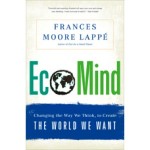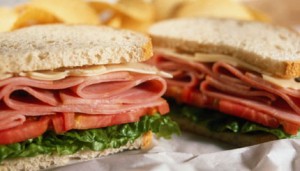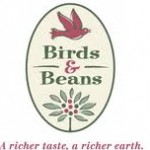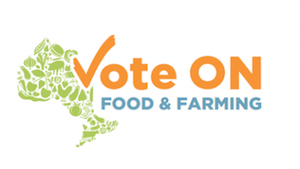Food ideas
 It’s always exciting to discover a strong voice in the good food movement. And it’s always humbling to realize that the voice has been loud and clear for some time, you just didn’t know about it.
It’s always exciting to discover a strong voice in the good food movement. And it’s always humbling to realize that the voice has been loud and clear for some time, you just didn’t know about it.
If you’re reading this, you have probably heard of Diet for a Small Planet, a ground-breaking book written in 1971 by Frances Moore Lappé that critiqued grain-fed meat and argued that bad food policy is the cause for food scarcity. Maybe you have a copy of this book sitting on your shelf. Maybe it turned you on to healthy eating decades ago. (I was eating hot dogs and cheese whiz in the 70s).
Two nights ago, I had the pleasure of hearing Frances Moore Lappé speak at Wychwood Barns, in Toronto, as part of a tour for her new book, EcoMind.
I’ve got to admit she left her audience feeling very inspired.
She argues that there is plenty of food in this world to go around for everyone, but scarcity exists due to our food policies, which allow for uneven and unfair food production and distribution.
Scarcity is human-made. And as the Global North grabs up chunks of Africa the size of France for farmland, it doesn’t paint a pretty picture for the future. The health hazard here is not the lack of food, it is the food supply chain.
Lappé suggests that as along as Money controls the politicians, and the politicians allow policies that help Money, the food situation will only worsen.
But Lappé gives hope – because, after all, no one wakes up in the morning anticipating wonderful ways to really screw things up for people less fortunate.
She gives concrete examples of how change is possible. From re-greening efforts in Niger that successfully created 12.5 million acres of new fertile land, to 8000 villagers in Andrah Pradesh agreeing to avoid farming with pesticides, to President Lula’s Forme Zero, in Brazil, which made food access a human right, to Wangari Maathai, who founded the Green Belt Movement in Kenya and won a Nobel Peace Prize for her work.
Lappé’s new book, EcoMind, explains how our mindset can have a lot to do with what we see as possible. If we don’t think differently, we will never solve our current crisis. From food availability to food quality, the current system does not work for 99% of the people living on this planet, nor does it work for 100% of the Earth itself.
If you care about food, read this book.
“The liberty of a democracy is not safe if the people tolerate the growth of private power to a point where it becomes stronger than their democratic state itself. That, in its essence, is fascism …”
– Franklin D. Roosevelt, addressing U.S. Congress, April 29, 1938.
A major Canadian supermarket has had to recall some of its organic baby food. The Canadian Food Inspection Agency issued a warning that some President’s Choice Organics baby food might be rancid. As a result, President’s Choice has voluntary recalled some if its PC Organic Infant Cereals.
Considering the little ones eating this food and their still developing immune systems, this is a serious concern. But parents, people – all of us – should always give food a good smell before eating it.
A woman I know in Montreal lost her sense of smell after giving birth. It was just one of those weird body-things that happen. It took years for it to return. In the meantime, her one greatest concern was not being able to smell foods before she gave it to her (by then) toddler.
Unless you’ve lost your sense of smell, check food first. Always. And especially if you didn’t make it yourself.
Food goes off. Packaging can be compromised. No one wants it, but it happens.
From the comments that follow the article that I read on CBC.ca, people are worked up and swearing off organics. In my view this is both ridiculous and reactionary.
Organic food goes off faster than processed foods precisely because it is not filled with chemical preservatives that artificially extend shelf life. If you choose to eat organic, it is likely because you want to avoid these preservatives.
We’ve become so accustomed to assuming food is always safe that we have forgotten (or are too busy, distracted, what have you) to simply use common sense.
Check the expiry dates, check the packaging, and give food a good sniff before you heat and before you eat. And let’s hope no one is seriously hurt by this.
As you may have heard, a California woman is suing the maker of Tropicana orange juice for misleading consumers that their product is “100% pure and natural” when it allegedly is not.
In her class action lawsuit, Angela Lewis said Tropicana deceives consumers by misrepresenting its Pure Premium juice in advertising and packaging.
Tropicana claims “16 fresh-picked oranges [are] squeezed into each 59oz container.” But according to Lewis, PepsiCo Inc. processes their juice extensively, and adds chemical aroma and flavours that change the juice’s “essential nature” and extend shelf life.
For its part, Tropicana has issued a statement that it “remains committed to offering great-tasting 100 percent orange juice with no added sugars or preservatives. We take the faith that consumers place in our products seriously and are committed to full compliance with labeling laws and regulations.”
Dig a bit online and you find that the packaging and advertising claims of other well known brands have also been challenged with class action suits, including Old Orchard, Welches White Grape Juice, Ben and Jerry’s All Natural Ice Cream and Quaker oats.
Now I don’t think it’s surprising that companies make claims about their products being natural, after all this is what people want. And companies are in business to give us that.
With a “premium” product, Tropicana can profit from the public’s desire for natural products, and charge a premium price.
The problem is that natural is not a regulated term like organic or certified organic. It’s the public that seems to think that natural is some kind of guarantee of quality. It is not.
Natural doesn’t mean anything in the food industry … except that we may be more likely to buy it.
It will be interesting to see what happens with this case.
Recent events in the Czech Republic, where I spent some time in the 1990s, have changed how I see the holidays this year.
In his work, the late Vaclav Havel, former Czech president, revolutionary, dissident and playwright often focused on the concept that even the powerless have power.
Havel had a gift of making lofty and seemingly difficult challenges appear simple and straightforward. He did this by appealing to our sense of decency. For example, a lone shop keeper can stand up to an entire regime he does not agree with by simply making the choice to not post a sign in his store.
I think Havel managed to make change possible because he would bring an idea down to its most basic level—big change on a small scale.
He simply asked us to live in truth.
When I think about our situation in the West regarding our mainstream food system, and its complicated relationship with industry and politics, which somehow pits yield and profit against quality, I am tempted to just bring it all down to its most basic level.
We can exercise our plea for accessible, decent, healthy food through the little choices we make every day.
We can stand up against the plethora of “edible food-like substances” that line our grocery store shelves and fill our world with advertising by simply making the choice to not buy them.
Could it be that simple?
There’s a new grocery store model under development in the U.S. If it catches on, it might just change American eating habits.
in.gredientsis slated to open in East Austin, Texas, as soon as they get their building permit approved. Co-founded by brothers Joseph, Christian, and Patrick Lane, and partner Christopher Pepe, they describe themselves as the first package-free and zero-waste grocery store in the U.S.
The concept is reassuringly simple: sell food from local vendors in bulk to customers who bring their own containers to the store. Customers will be able to buy fresh local produce in season, organic grains, spices, loose tea and coffee, dried fruits and nuts, flours, oils, dairy, local meats, local beer and wine, and household cleaners and toiletries.
Customers will bring clean containers from home, weigh and label the containers at the store, fill the container with a food item, bring it to check out, and then pay. They will also have the opportunity to allocate a portion of their purchase to a charity.
You only pay for the food you want (not the packaging, estimated to add 10-20% to your grocery bill), and for the amount your want (only need a ½ a teaspoon of sage? Not a problem). Compostable containers will also be available for purchase at the store if you don’t have any of your own.
in.gredients will be waste-free, local, and — as much as possible — organic.
The goal of this community-minded business is to reduce waste and improve the availability of healthy food in an area that is otherwise something of an urban food desert.
According to their website, single-use packaging makes up 40% of the 1.4 billion pounds of waste that are dumped in American landfills every day. Yes, that’s packaging that is used once and then tossed out.
By doing away with the packaging at the start, the group is putting the emphasis on the Reduce and Reuse in the Reduce, Reuse, Recycle mantra.
They also call it precycling.
Whatever you want to call it, less is definitely more in this case, as even recycling our current packaging requires energy and the burning of fossil fuels.
I wish these guys all the best. I hope they go far. And I hope they give other Austin-based food giants a healthy run for their money, as the more “good food” out there, the better it is for everyone. That said, education will be key in converting a customer base that is otherwise used to buying and eating processed or convenience food.
What is at stake here is not just a different shopping experience that asks you to bring your own jars and containers to the store. in.gredients is essentially asking people to purchase real food, ingredients if you will, and prepare their meals from scratch. This, in my view is the real challenge.
I look forward to hearing their success stories.
I was excited to see that a local organic meat supplier has some new nitrite-free deli items for sale. It seemed perfect: a reputable family farm that does everything right (organic and grass-fed, pasture roaming, natural breeding, etc.) comes up with carcinogen-free deli meat?
So I can have the quick easy lunch that lets me regale in the simple salami sandwich of my youth and not get cancer!
Nitrites (NO2) and their cousin nitrates (NO3) are used as a preservative in cured meats to prevent botulism. They give salami, hot dogs and bacon a longer shelf life and that reddish colour that we tend to associate with “fresh”.
The problem is that nitrates, which convert to nitrites in our digestive tract, were linked to cancer in children back in the 1980s.
Nitrites can also occur naturally in certain foods, such as celery. But for some reason, these nitrites are not found to be carcinogenic. Perhaps this is due to the detoxifying vitamin C that celery also contains.
Chatting with a chef-friend yesterday, I was assured that you cannot cure meat without nitrites. It’s “simply part of the process.” She says that if you are curing meats in your basement for family use, for example, you might get away with not using nitrites. If you get botulism, it’s your own fault. But if you’re selling the meat, and exposing yourself to potential lawsuits, you use nitrites, also called pink or curing salt.
So then how are meat suppliers making their nitrite-free meats? Apparently, many replace nitrites with celery juice or celery powered extract, which —as mentioned— contain nitrites.
Personally, I do not feel the label “nitrite-free” in this case is accurate, or perhaps even ethical. After all, nitrites are still in there. The only difference is that no one picked up a container of pink salt and poured it in. They simple added an ingredient that contains naturally-occurring nitrites. Perhaps a more honest label would be “no nitrites added”?
It remains to be seen if “nitrite-free” deli meats are less carcinogenic that regular deli meats. It is possible that the celery makes a difference.
The trick, I think, is to eat these treats in moderation. If it’s local and organic, I’m not cutting it from my diet. But I will, perhaps, make an effort to enjoy them in the traditional French charcuterie style, i.e. with a few vitamin C containing vegetables on the side.
I’ve been noticing the birds this year, migrating south. It’s a beautiful site to behold if you don’t think about what it means: “See ya, suckas, we’s outta here!”
They are not so dumb, those birds. They are off to warmer climes in South and Central America, where hopefully there is a forest waiting for them, or at least some agroforestry that has not completely destroyed their winter habitat.
Yes, bird habitat is decreasing and, strange as it may sound, your cup of coffee has a lot to do with it.
As you already know, the clear cutting of tropical rain forests is destroying traditional bird sanctuaries, not to mention entire ecosystems. As a direct result, bird populations are decreasing. And by birds, I mean local and migratory birds. And by migratory, I mean our birds, or the ones we like to think of as ours – the ones we say good-bye to each fall and welcome back each spring.
Some of these birds return to their forested nesting ground only to find wide-open field. With nowhere to nest, they perish. Some, however, are able to seek refuge in shade coffee farms – farms that use a natural tree shade canopy to grow its crop.
However, after chatting with Madeleine Pengelley, owner of certified Bird Friendly® Birds and Beans roastery and café, I understand that not all shade coffee farms are created equally.
Coffee is naturally a shade-loving plant. Although originally imported from Africa, coffee can grow wild in South and Central American forests. It has also been traditionally grown for centuries in small-scale, rustic shade farms that make use of the natural forest canopy, usually old growth or secondary forest, to produce slower ripening and richer tasting coffee.
In the 1960s, in the name of progress and higher yield, a strain of coffee was developed that was able to tolerate the bright sun. Farmers cleared their land, sold their lumber, and planted the new coffee.
Yes, yield went up and so did sales, but bean quality and taste went down — as did local water and soil quality, animal and bird populations, and any extra income farmers might have earned from wood or fruit products provided by the former forest.*
As a result, shade coffee farms began to emerge as a new trend to counteract the negative effects of sun-grown coffee. These farms use a number of assorted shade trees and other plants to create a canopy that enables the type of symbiotic ecosystem that supports life and sustainable coffee cultivation.
Shade farming works with the environment, not against it; as a result, it doesn’t require the chemical inputs like fertilizers, pesticides, fungicides and herbicides that clear cut coffee farms have come to rely on.
Shade coffee farming is an organic and sustainable model that offers protection to endangered birds and wildlife, not to mention a viable livelihood for local farmers and unpolluted water to all communities downstream.
Unfortunately, economic realities being what they are, even well intentioned shade farmers are at times forced to chop down a few trees. The income from the lumber can be the difference between a child going to school that year or not. And the next year, it can be the same story.
I find no fault with the farmers who are simply doing what is necessary to get by, but if we could make the living tree more valuable to a farmer than the lumber it produces, then we’d be getting somewhere, says Madeleine.
Working towards this model is the Smithsonian’s Migratory Bird Center’s Bird Friendly® coffee certification program, which encourages coffee farmers to follow specific shade management practices. The various criteria include canopy height, foliage cover, tree diversity, leaf litter, and so on, all of which guarantee a minimum shade of 40% and an organic, sustainable and fair trade product.
Coffee ain’t local food where I live. But when you can’t go local, you go organic, sustainable, fair trade and, now, Bird Friendly®. This is not yet another food certification for you to contend with, this makes a lot of sense and does affect you in your own backyard. They are your birds too.
We do have the ability to change this particular problem because it is motivated by our own consumption habits.
Take a minute to sip on that.
* Read more about food sovereignty and agroforestry in Wayne Roberts’ The No-Nonsense Guide to World Food, 2008, ISBN 978-1-897071-44-1.
The Vote ON Food & Farming campaign has officially launched. (Seems I was a bit premature last week.)
Created by Sustain Ontario, Vote ON Food & Farming aims to raise awareness of key food issues that touch on health, the environment, kids, communities, farmers, and jobs.
All Ontarians, no matter where you live, are asked to promote food and farming as important election issues in the upcoming provincial election (Oct. 6, folks).
The Vote ON site is worth a visit. Take the pledge to vote for a candidate who supports food and farming issues, and then let all the candidates know how you feel.
Curious where each party stands on food and farming? Check out the Report Card to see which parties have policies and which come up dry. The findings might surprise you.
Take the Good Food Quiz to test your own knowledge. It’s a bit of an eye opener how many people rely on food banks in Ontario, and how little income farmers make.
If you’ve got some bright ideas or solutions of your own, submit your Good Food Idea, in writing or video, and let others bask in your genius. (No, really, we need to get the discussion going. Submit your ideas.)
Get informed & get involved. After all, it’s your health – environment – kid – community – job at stake!
What strikes me is that even if you don’t live in Ontario, you know that these same issues affect your province or state just the same.
That said, if you are in Toronto this weekend…
Not Far from the Tree and Spadina Museum are hosting City Cider, an opportunity to sip freshly pressed, local apple cider in a heritage orchard. Music, food, activities too!
When: Sunday, 18 September, 1 pm – 5 pm
Where: 285 Spadina Road
Cost: only $5
Something good is happening. It’s happening slowly, but it is happening nonetheless. People – institutions even—are beginning to see that having accessible healthy food is a necessity, something worth fighting for, and do-able.
In the US, the Huntington, West Virginia school made famous by chef Jamie Oliver’s tough love reality TV show “Food Revolution,” in which Oliver lambastes school directors for the poor quality food served to students, has now overhauled its food services to provide local, fresh, made-from scratch meals. And they achieved this in only two years. Today, the school is pretty much a model for what can be done.
And while hard-core foodies of various stripes may look down their noses at popular, for-the-masses TV shows like Food Revolution, the movement seems to be catching.
Here in Canada, with the new school year just started, schools throughout Ontario have implemented widespread improvements to the food available in cafeterias and in vending machines to help combat childhood obesity. Gone are the French fries, candy bars and colas. Say hello to baked potato wedges, thin crust multi-grain lo-so pizza, and juice.
While I think cafeterias could go farther in their step towards healthier meals, this is undeniably a step in the right direction.
Even hospitals are jumping in –- that last bastion of inedible food. In Scarborough, Ontario, a hospital has undertaken a one-year experiment to improve its food services and provide fresh, local food and scratch cooking to its patients.
Get the picture?
Even the higher ups, those who may arguably gain in the short term from lowering standards and cutting corners, recognize the value of food and the connection between food and health.
Times are changing. Food is becoming a mainstream issue. In the upcoming provincial elections happening throughout Canada, I encourage voters to make food an election issue.
In Ontario, visit Sustain Ontario to learn more about their Vote ON Food campaign.
…
In other happy food news:
If you’re in Toronto this weekend, it’s the 27th Annual Vegetarian Food Festival. Free event!
Where: 235 Queens Quay West
When: Friday 4 pm – 9 pm
Saturday 12 pm – 9 pm
Sunday 12 pm – 7 pm

They have ripped up the better half of Dundas St. between Dovercourt and Lansdowne for sidewalk and streetscape reconstruction. It’s noisy and messy. But on the bright side the construction company seems to have learned from its mistakes on the north side of the street, because the crews have been pretty good, on the south side, helping mothers with strollers navigate the ramps and trenches to access the store where I work.
Rumour has it they’ll be ripping it all up again in October for more work, leaving me with no questions as to how our city money is spent and re-spent. Well, maybe one question.
Why?
I’m told that when the city has street work to be done, it has construction companies bid on the job. According to one insightful healthy food shopper, the scenario goes something like this:
1. Company 1 bids on the job saying that it will cost the city x dollars and take y time.
2. Company 2 makes a bid saying they can do it for half the cost and in half the time…because they have a dragon to help them.
3. Impressed, the city goes with company 2.
What happens then is that the job drags on, taking longer than scheduled, and ends up costing much more than quoted because, as we all know, there’s no such thing as dragons!
Now, you might think the city would do some research beforehand to cost their projects before believing in impossible fantasies. But they don’t. And so they do not know the real cost of things—which in the end costs us more.
It is a bit like the cost of food.
A real tomato does not cost 30 cents. This is what a tomato-like fruit costs, with added chemical fertilizers, pesticides and herbicides because it is grown in depleted soil, and is likewise depleted of nutrients, like vitamin C, and has little flavour.
The cost of a real tomato grown under the sun in healthy soil, containing all the good taste and nutrients we expect from fresh food, is $1. That is the real cost. It is more expensive, but it is the cost of doing it right. The good thing is that there are no hidden costs that follow. In fact, you are compensated for the higher price with a cleaner environment, more vibrant local economy, and healthier food.
Doing things right the first time costs more, but at least we only have to pay it once.




